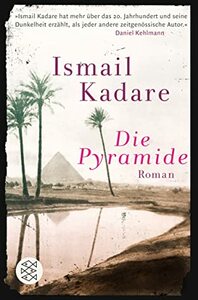Take a photo of a barcode or cover
challenging
dark
reflective
fast-paced
Plot or Character Driven:
Plot
Strong character development:
Complicated
Loveable characters:
No
Diverse cast of characters:
No
Flaws of characters a main focus:
Yes
Graphic: Death, Violence
Moderate: Misogyny
Minor: Rape, Sexual violence
challenging
reflective
medium-paced
Another strangely mystical one by Kadare- this one chronicles the building of an Egyptian pyramid. It re-creates that ancient scene in small pieces and images. It's a sort of chronicle of the process for the builders, as well as for the king who is to be entombed in it. I love the passages that describe each stone, and the history of their journey from the quarry to the pyramid, killing masons and stonelayers along the way. Reading it right now is connected with a new series of drawings I am making, based on images from Ancient Near Eastern art.
dark
informative
mysterious
fast-paced
Plot or Character Driven:
A mix
Strong character development:
No
Loveable characters:
Complicated
Diverse cast of characters:
Complicated
Flaws of characters a main focus:
Complicated
I had high hopes for this book, but in the end, I found it dull and uninteresting. Moments of good writing surrounded by meh
To be honest, this is rather a dessicated account of the bloody process of building of Cheops's pyramid - with obvious significance in Albania, as Hoxha's intended mausoleum is a squat and particularly ugly pyramid (designed by his architect daughter) on prime land in the centre of Tirana (with a pretty nice parklet around it, granted). At least, from the ground it's ugly; from the air it's a representation of the the Albanian eagle and rather more impressive. Hoxha has long lain elsewhere, the pyramid still seems solid but the various doors are a patchwork of broken bits and pieces, it's covered in graffiti and it's mainly used by young people who run up the slopes and hang out on the flat top. There's also an occasional nightclub operating in a back entrance, called Mumja.
So anyway this is a short and serviceable but uninspiring account of dictatorial behaviour, of using economy-collapsing projects specifically to keep the people occupied and unhappy, and of labyrinthine bureaucracies where the system is everything and no one seems to be actually in charge. There are probably a lot of Albanian references here, but I only got a few of them. It's rather difficult to see what exactly Kadare is doing with this, other than the broad comments about vanity projects, dictatorships and a put-upon population, but the mention of Albania's pyramid and all its little pyramids (the bunkers) was resonant, and probably more so to those who were on the spot when Hoxha's pyramid was happening.
This was written in the years just after the pyramid itself was completed, in 1988. There's probably a more interesting book in the inconsequential dithering over what should become of it now - here's a taste. The latest was a contest during the Architecture Week last September which invited proposals for it; none were particularly memorable. Also.... this book predated the growth and collapse of the pyramid schemes in Albanian (with such a violent outcome) but not by much. I wonder what I should be finding anything in the book that prefigures the rest of that messy decade in Albania.
So anyway this is a short and serviceable but uninspiring account of dictatorial behaviour, of using economy-collapsing projects specifically to keep the people occupied and unhappy, and of labyrinthine bureaucracies where the system is everything and no one seems to be actually in charge. There are probably a lot of Albanian references here, but I only got a few of them. It's rather difficult to see what exactly Kadare is doing with this, other than the broad comments about vanity projects, dictatorships and a put-upon population, but the mention of Albania's pyramid and all its little pyramids (the bunkers) was resonant, and probably more so to those who were on the spot when Hoxha's pyramid was happening.
This was written in the years just after the pyramid itself was completed, in 1988. There's probably a more interesting book in the inconsequential dithering over what should become of it now - here's a taste. The latest was a contest during the Architecture Week last September which invited proposals for it; none were particularly memorable. Also.... this book predated the growth and collapse of the pyramid schemes in Albanian (with such a violent outcome) but not by much. I wonder what I should be finding anything in the book that prefigures the rest of that messy decade in Albania.
pembukaan novel ini meminta agar kita memandang piramid bukan melulu sebagai obyek, namun sebagai alat di mana kekuasaan beroperasi.
ketika cheops berniat menghentikan tradisi moyangnya dalam membangun piramid, serentak seluruh istana terkejut dan mencari dasar-dasar pembelaan mengapa struktur itu perlu selalu dibangun.
melalui penjelasan para pujangga yang menelisik dokumen-dokumen untuk membela perlunya firaun cheops melanjutkan tradisi membangun piramid kita diberi tahu bahwa piramid itu adalah alat untuk meluhurkan posisi raja [dengan merendahkan posisi rakyat].
kehendak membangun piramid itu lahir karena krisis, bukan krisis karena kekurangan tapi justru karena keberlimpahan, kemakmuran.
kemakmuran membuat rakyat mandiri dan berani membangkang pemerintah, dan satu-satunya cara untuk keluar dari krisis adalah menghilangkan kemakmuran. bisa dengan banjir, bencana alam, gempa bumi, perang,.... dan yang terakhir dan akhirnya terpilih adalah menyelenggarakan kerja raksasa yang melampaui imajinasi.
yang akan meletihkan rakyat, menghancurkan jiwa-raga, dan yang tidak ada manfaatnya bagi mereka....selain demi kekuasaan negara.
proyek raksasa itu bukan kuil atau istana, tapi makam. strtuktur tak berguna yang berfungsi sebagai pemenuhan kebesaran kekuasaan raja, yang dengan itu maka kebesarannya akan abadi.
"sebuah piramid, sebelum bermanfaat di akhirat, memiliki fungsi di dunia ini. dengan kata lain, sebelum menjelma demi ruh, menjelma demi tubuh", demikian ujar pendeta tertinggi hermiunu.
akhirnya,
piramid pun jadi dibangun, yang terbesar dan tertinggi dari yang pernah ada sebelumnya.
saya tidak tahu kapan novel ini ditulis, tapi melihat tahun penerbitan perdananya dalam bahasa prancis 1992, situasi dunia ketika penulisan novel ini sudah berlimpah sumber-sumber yang lengkap mengenai proses pembangunan sebuah piramid mesir. penulis menulis ulang dengan perspektif lain. atau lebih baik, ia menulis sesuatu yang lain melalui deskripsinya tentang piramida cheops. ia menulis tentang kekuasaan.
yang agak mengherankan saya, di novel ini proses perencanaan piramid diceritakan menggunakan gambar-gambar. demikian pula riset para pujangga ke perpustakaan mereka pun lari ke gambar-gambar piramid-piramid masa lalu mereka. benarkah gambar [di atas papirus] sudah menjadi alat produksi pembangunan di masa itu, sementara orang sumeria digambarkan masih membawa-bawa tablet lempungnya?
itu yg bikin aku ngerasa "enggak" terhadap buku ini karena mengisahkan cara membangun struktur raksasa 4000 tahun silam seperti orang membangun di masa kini.
tapi idenya menarik: memahami makna pembangunan sebagai upaya pelemahan rakyat dan sekaligus pemuliaan penguasa.
ketika cheops berniat menghentikan tradisi moyangnya dalam membangun piramid, serentak seluruh istana terkejut dan mencari dasar-dasar pembelaan mengapa struktur itu perlu selalu dibangun.
melalui penjelasan para pujangga yang menelisik dokumen-dokumen untuk membela perlunya firaun cheops melanjutkan tradisi membangun piramid kita diberi tahu bahwa piramid itu adalah alat untuk meluhurkan posisi raja [dengan merendahkan posisi rakyat].
kehendak membangun piramid itu lahir karena krisis, bukan krisis karena kekurangan tapi justru karena keberlimpahan, kemakmuran.
kemakmuran membuat rakyat mandiri dan berani membangkang pemerintah, dan satu-satunya cara untuk keluar dari krisis adalah menghilangkan kemakmuran. bisa dengan banjir, bencana alam, gempa bumi, perang,.... dan yang terakhir dan akhirnya terpilih adalah menyelenggarakan kerja raksasa yang melampaui imajinasi.
yang akan meletihkan rakyat, menghancurkan jiwa-raga, dan yang tidak ada manfaatnya bagi mereka....selain demi kekuasaan negara.
proyek raksasa itu bukan kuil atau istana, tapi makam. strtuktur tak berguna yang berfungsi sebagai pemenuhan kebesaran kekuasaan raja, yang dengan itu maka kebesarannya akan abadi.
"sebuah piramid, sebelum bermanfaat di akhirat, memiliki fungsi di dunia ini. dengan kata lain, sebelum menjelma demi ruh, menjelma demi tubuh", demikian ujar pendeta tertinggi hermiunu.
akhirnya,
piramid pun jadi dibangun, yang terbesar dan tertinggi dari yang pernah ada sebelumnya.
saya tidak tahu kapan novel ini ditulis, tapi melihat tahun penerbitan perdananya dalam bahasa prancis 1992, situasi dunia ketika penulisan novel ini sudah berlimpah sumber-sumber yang lengkap mengenai proses pembangunan sebuah piramid mesir. penulis menulis ulang dengan perspektif lain. atau lebih baik, ia menulis sesuatu yang lain melalui deskripsinya tentang piramida cheops. ia menulis tentang kekuasaan.
yang agak mengherankan saya, di novel ini proses perencanaan piramid diceritakan menggunakan gambar-gambar. demikian pula riset para pujangga ke perpustakaan mereka pun lari ke gambar-gambar piramid-piramid masa lalu mereka. benarkah gambar [di atas papirus] sudah menjadi alat produksi pembangunan di masa itu, sementara orang sumeria digambarkan masih membawa-bawa tablet lempungnya?
itu yg bikin aku ngerasa "enggak" terhadap buku ini karena mengisahkan cara membangun struktur raksasa 4000 tahun silam seperti orang membangun di masa kini.
tapi idenya menarik: memahami makna pembangunan sebagai upaya pelemahan rakyat dan sekaligus pemuliaan penguasa.
I struggled with this book. I constantly felt that there was social commentary buried in the prose, but couldn't decipher exactly what it might be. The political history of Egypt?
Kadare began with very literal descriptions of the process of building a pyramid, and then veered off to a figurative path that I could not follow. Mainly I got a 'serious literature' vibe from this book and yet sometimes I felt like he was just one good turn of phrase away from Terry Pratchett territory.
Kadare began with very literal descriptions of the process of building a pyramid, and then veered off to a figurative path that I could not follow. Mainly I got a 'serious literature' vibe from this book and yet sometimes I felt like he was just one good turn of phrase away from Terry Pratchett territory.
challenging
dark
funny
slow-paced
Plot or Character Driven:
Plot
Strong character development:
Yes
Loveable characters:
No
Flaws of characters a main focus:
Yes
"It was a bloodstain that neither water nor acid would ever wash clean."





